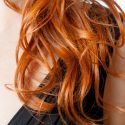Damaged hair? This hair regenerating technique will help you
Bleaching hair or dying it is the prelude to their worsened condition. But these chemical substances are frequently accompanied with other harmful factors such as: hot airstream generated by a hair-dryer, flat iron and hair products providing extra hold (gels, hair sprays, hair mousse – all of them having ‘strong’ fix). Frequently, hair also gets damaged due to adverse weather conditions. Is it possible to regenerate the strands without reaching for the ultimate solution, that is having it cut at a hairdresser’s? Before you go for this final cut – give a try to hair oil treatment. It does work wonders and is able to help you say goodbye even to the heavily dehydrated, stiff and bleach-damaged hair.
Damaged hair, so what exactly?
Damaged hair isn’t only dry, gets frizzy easily and is stiff. Damaged is also the hair which lost water from its inner structures, isn’t able to maintain the hydro-lipid barrier in a good condition, ‘gives back’ almost all nourishing substances and which hair shaft is knackered by fractures. In extreme situations damaged hair has broken sulphur bonds, which translates into changed hair structure – this happens when you often use a flat iron; simply, the high temperature the tool generates burns hair. Damaged strands fall out excessively, have weakened bulbs, are frequently brittle and their ends is fast to split.
How to regenerate damaged hair? Hair oil treatment
Damaged hair can be cut – but if we don’t change our approach to hair care, the effect will be exactly the same: damaged strands that must be ‘saved’ with scissors. Obviously, split ends have to be trimmed because (despite some idolatrous assertion of hair product producers) there is literally NOTHING that is capable of fixing split ends. However, inner and external hair structures can be repaired and this can be taken for granted. Therefore, it’s not worth going for drastic cuts – after all, there is plenty of oils and oil blends to choose from owing to which you can literally give a new lease of life to hair damaged by colour treatment and bleaching.
Natural oils for hair regeneration – Why do they work?
Obviously, natural oils have long been known. Basically, each part of the world has its own ‘Oil King’ that has been taking care of women hair for centuries. In Europe the most favoured oils are: olive oil, castor oil and linseed oil.
Undoubtedly, the masters of hair oiling are Hindu women. Beautiful, strong and waist-length hair is their pride. Why do they have so incredibly stunning hair? Naturally, it’s partly owed to genes and even the healthiest hair can be brought to ruin. The key here is the matching care, which in this case is hair oil treatment.
Natural oils have a few marvelous and untypical (I don’t want to say magical) properties:
- They create an occlusion layer, therefore they make sure that hair inner and outer structures aren’t getting damaged.
- Prevent water loss from inner hair structures and lock there the precious nourishing substances. Thanks to this, hair wins the chance to regenerate.
- They supply hair with a set of nourishing substances: beginning with many vitamins, flavonoids and phytosterols, through essential fatty acids, beta-carotene and minerals that are crucial for hair to grow long.
- Take care of scalp. Prevent dehydration, and when hair is fast to get greasy, oils help regulate sebum production.
- Take care of hair bulbs – and this is the very unique quality of oils; bulb reinforcement is the core of each hair type regeneration, even the heavily damaged hair.
Hair oil treatment – How to do it right?
Hair oiling isn’t complicated at all. It resembles applying a hair mask (and scalp mask) but the action delivered is definitely longer. The oils have to match hair type and its porosity. Then, they can be rubbed into dry hair and scalp. The other technique depends on washing hair first (best if it’s a strongly cleansing shampoo that help hair cuticle rise which translates into increased hair absorption rate) and when damp and toweled, the hair can be covered with an oil.
The oil should sit on hair for an hour (the longer the better), however, if applied to damp hair, it can be removed already after 30 minutes.
After oiling, hair should be shampooed again so as to prevent the oily molecules from weighing hair down. The last step to take is application of a conditioner that will close the hair cuticles and smooth hair structure out.






Leave a Reply